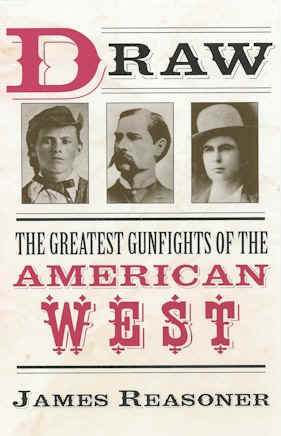 The Wild West is one of those times and places that pulls strongly on our imagination, with images of danger, adventures, and freedom. Daring bank robberies, shoot outs, posses chasing outlaws through the wilderness, saloons and gambling. Men such as Billy the Kid, Wild Bill Hickock, Wyatt Earp, Bat Masterson, Doc Holliday. These are the icons of the Wild West. Typically, however, we have next to no real inkling of the real Wild West, with most of our knowledge informed more by Hollywood than history. In his book Draw, James Reasoner explores the truth behind the stories of these men and their exploits, truths that are often as exciting and interesting as anything Hollywood could ever invent.
The Wild West is one of those times and places that pulls strongly on our imagination, with images of danger, adventures, and freedom. Daring bank robberies, shoot outs, posses chasing outlaws through the wilderness, saloons and gambling. Men such as Billy the Kid, Wild Bill Hickock, Wyatt Earp, Bat Masterson, Doc Holliday. These are the icons of the Wild West. Typically, however, we have next to no real inkling of the real Wild West, with most of our knowledge informed more by Hollywood than history. In his book Draw, James Reasoner explores the truth behind the stories of these men and their exploits, truths that are often as exciting and interesting as anything Hollywood could ever invent.
Reasoner focuses on gun fights, the violence that characterized the lives of these men. Some of these men were out-right sociopaths, killing with no emotion nor remorse, over things as trivial as snoring too loudly (ok, that was an accident, but there was still no remorse). Often motivated by the desire for wealth, many of these men started off on gangs that robbed stage coaches, trains, and banks, but soon events got beyond their control, with posses in chase and life on the run. Some were able to escape justice for a while, settling in another territory or moving back east, but often, the bullet eventually found its target.
Draw looks at some of the lesser known gun battles of the Old West, sometimes skipping the more well known ones almost altogether. For example, the shootout at the O. K. Corral is only briefly touched on as part of the context of the death of the one Earp brother who wasn’t there. Not much is made of the two most notorious outlaws, Billy the Kid and Jessie James, except in how their deaths were part of the narrative of other men. Maybe that’s because these more famous events and men have so much more written about them that Reasoner figured there wasn’t a need for even more, focusing instead on the lesser known battles. In any case, the events and men he has chosen are compelling.
There are a couple of things I found very interesting. Reasoner tries to emphasize is that the Old West image of two men facing each other on Main Street in a showdown, an image that some historians have said is pure Hollywood fiction, did occur at least a few times. He gives a couple examples of exactly this kind of shootout. Also very interesting is how much New Mexico plays in the history of the Wild West. When we hear of the exploits of Billy the Kid and so on, we don’t have much context for the where of it, just a generic western setting. However, many of these men lived and worked and robbed in New Mexico, as well as Kansas, Colorado, Texas, and California. It makes me want to find some of these places in New Mexico and see what there might be to see. Finally, Reasoner describes some truly remarkable men — on both sides of the law — who, facing a barrage of bullets, kept their cool to gun down their enemies. They let the others wildly shoot away while they steadied their aim and let loose a deadly shot. Fast wasn’t always the most important factor in who won the day.
Probably the most interesting aspect of all of this is when these events occurred. These stories involve men who span the worlds of the Civil War to World War I. Many were either Confederate or Union soldiers who moved West to find their fortune. But the last few events described occurred around 1917, near the end of WWI. To me, this was a near epiphany as WWI, having occurred in the 1900s, feels like the modern era, while the Old West seems to be another time. But they overlap. And, indeed, there was less time between the Civil War and WWI than there is now between WWII and our own time. Thus, the backdrop of the Civil War was likely very important context for most of these men, regardless of what side they were on. That, while in Europe men were dug into trenches and airplanes were engaged in aerial combat, men in the US were still robbing banks by horseback is just a bit amazing to think about.
I only found one aspect of Reasoner’s writing a bit annoying. In setting up each story, he gives some context to the time and place and more than once uses a phrase such as “The bustling town grew up around the miners who dug their wealth from the ground and the saloon keepers and soiled doves who came to extract that wealth from the miners.” This type of phrase — though probably very accurate — got a bit repetitive, but maybe that shows how similar all of these western settlements were at the beginning.
Draw is a very entertaining read and has me looking for more about the Old West.